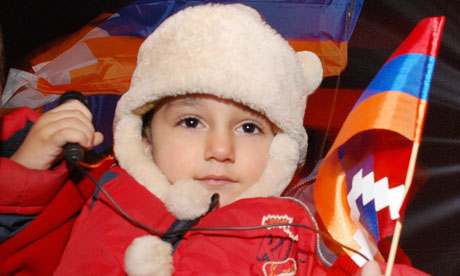(guardian.co.uk) The leafy boulevards of Stepanakert, in Nagorno-Karabakh, are beginning to attract visitors, but to most of the international community the republic doesn't exist.
Dan Peleschuk, Guardian Weekly, Tuesday 28 August 2012
 |
| Photograph: Karen Minasyan/AFP/Getty |
In many ways, Stepanakert resembles a small American town on the rise. Its main boulevards have been repaved, locals stroll through the renovated central square past its elegant fountain, and hotels have sprouted on every other block to hold the new influx of visitors.
But as some people see things, it doesn't really exist, and neither does the ethnic Armenian Nagorno-Karabakh Republic, of which Stepanakert is the capital. According to the rest of the world, the region belongs to Azerbaijan, and no one – not even Armenia, Karabakh's patron state – recognises it.
But that doesn't stop the self-proclaimed country from celebrating its 20 years of de facto independence this year. Patriotic banners flutter above Stepanakert's streets, and posters of the soldiers who during a bloody war in the early 1990s helped wrest the land away from Azerbaijan line the sidewalks.
Not long ago much of the city was in ruins and the economy virtually non-existent. Today locals meander along leafy streets lined with new banks, stores and government buildings. A tourism industry is slowly taking root, as travellers from across the world descend on the tiny republic, population about 141,000, in increasing numbers.
But under the surface are scars of a war that left more than 30,000 dead and many displaced. War is the only reason the Nagorno-Karabakh Republic exists. War – the memories of it, the fears of its return – is what makes it tick. Perhaps the best reminder of this is Aghdam, the ghostly shell of a former Azeri settlement levelled by Armenian forces in 1993. Just a short drive from Stepanakert, the one-time city of around 30,000 was reduced to grassy craters and jagged stone remnants of former apartments, schools and community centres. Visible from the only road that leads north to Karabakh's famed ancient monasteries, it is easy to notice.
Yet ordinary Karabakh Armenians are trying to capitalise on the relative post-war stability. Even as border tensions have escalated in recent months, which have seen deadly skirmishes between Armenian and Azeri forces, small-time businessman Ashot Simonyan says foreign visitors have continued to stream through his spare rental apartments.
"Everyone who comes here really loves it," he says with a salesman's grin. "We have everything a tourist needs – it's completely normal here."
Every week Guardian Weekly publishes a Letter from one of its readers from around the world. We welcome submissions – they should focus on giving a clear sense of a place and its people. Send them to weekly.letter.from@guardian.co.uk
• This article was inadvertently published on the web a week early, and with a different headline.











No comments:
Post a Comment